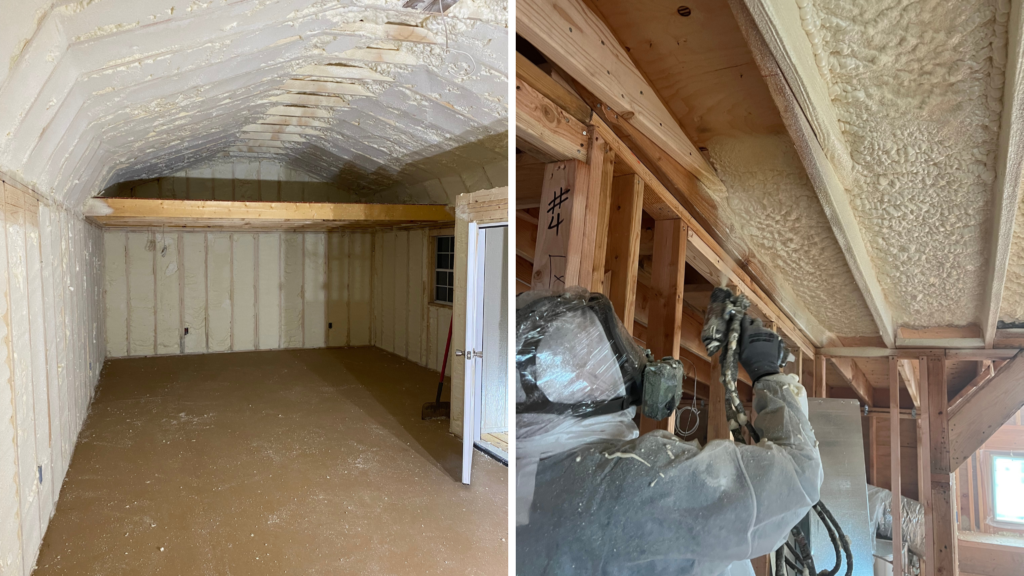
Embarking on a quest to enhance the energy competence of your dwelling? Your exploration might halt at two intriguing, yet very distinct, destinations – open-cell and closed-cell insulation. Each insulation variant flaunts efficaciousness, yet what sets them apart are some nuanced dissimilarities that could influence your decision. So, brace yourselves for an enlightening expedition into the nitty-gritty of these insulating wonders, enabling you to make an astute choice that aligns with your home’s needs.
Deciphering the Labyrinth of Spray Foam Insulation
Spray foam insulation, often hailed as a potent tool by homeowners and contractors alike, boasts an extraordinary talent – to metamorphose from a simple liquid to a formidable sealant capable of filling the minutest of crevices. The beauty lies in the growth, which forms an impenetrable shield that elevates the comfort quotient of your home, making it an energy-efficient haven.
However, spray foam insulation bifurcates into two distinct entities – the closed-cell and the open-cell. The decision between these two, while seemingly perplexing, hinges on the aspirations you harbor for your project, as both of these types come equipped with their own portfolio of singular traits and merits.
Demystifying Closed-Cell Polyurethane Spray Foam
Closed-cell spray foam insulation, the denser counterpart, manifests as a rigid foam, aptly filling gaps and cracks with its expansive persona. The insulation stalwart is lauded for its moisture-resistant quality, marking it as a reliable companion for areas battling dampness or humidity.
Among the several attributes that define closed-cell foam, one stands tall – the high R-value, a metric assessing a material’s resistance to heat flow. Sporting an R-value of roughly 7.0 per inch (R-7), closed-cell foam’s insulation prowess is a force to be reckoned with. Another facet that sets it apart is its propensity to reinforce a building’s structural integrity, thus making it an obvious choice for lending structural support.
Decoding Open-Cell Polyurethane Spray Foam
Open-cell spray foam insulation, the more flexible and less dense sibling, mirrors the closed-cell variant in filling gaps and crevices with aplomb. Despite its lower R-value, it commands respect for its insulation capability and potential to optimize energy expenditure. Unlike its closed-cell counterpart, open-cell foam embraces porosity, allowing moisture to seep through, a trait that can be harnessed favorably under certain conditions.
Open-cell foam shines in the arena of noise reduction, becoming a valuable addition to walls, floors, and ceilings, effectively minimizing sound transmission between rooms or across floors. The ease of installation and cost-effectiveness lend open-cell foam a competitive edge, making it an attractive choice for budget-conscious projects.
The choice between closed-cell and open-cell spray foam insulation lies not in determining the superior variant but in understanding and aligning their unique attributes with the specific demands of your project.
Introducing the Hybrid: Open-Cell and Closed-Cell Combo
For those yearning for the best of both worlds, the market offers hybrid spray foam insulation. A masterful blend of open and closed-cell foams, hybrid products promise a potent amalgamation of both types’ unique properties, all bundled into a single, efficient package.
The layered approach of the hybrid variant usually begins with a foundation of closed-cell foam, providing a robust, airtight seal. An overcoat of open-cell foam follows, further enhancing the insulation while curbing noise transmission. However, the spectrum of choices doesn’t end here. It ranges from closed-cell to open-cell, hybrid, and even low-pressure spray foams, each endowed with unique traits to cater to your diverse needs and goals.
Unraveling the Chemical Composition of Spray Foam
Beyond the apparent insulation types, a key aspect to consider is the chemical makeup of the foam. Fundamentally, two primary foam types – polyurethane and polyisocyanurate – find their extensive use in the realm of spray foam insulation. Polyurethane foam, widely employed for its sealing and insulating prowess, also boasts durability, making it a worthwhile investment.
Alternatively, polyisocyanurate foam is typically used to insulate commercial roofs’ exteriors and demonstrates resilience against fire and moisture. Analogous to the variety of insulation options, the decision between polyurethane and polyisocyanurate foams pivots upon the singular demands and ambitions embodied by your specific project.
Weighing the Environmental Impact of Spray Foam Insulation
When choosing the right spray foam insulation, it’s crucial not just to focus on your immediate needs but also to contemplate its long-term environmental implications. Several products incorporate renewable or recycled materials, thereby curtailing their carbon footprint.
Soy-based foam, a rising star in the insulation sector, merits attention for its eco-friendly stature. Derived from renewable resources, this biodegradable foam type is gentler on the environment compared to traditional insulation materials, making it a sustainable choice for eco-conscious projects.
Moreover, our EcoPolySeal Spray Foam, crafted from a blend of recycled materials and quickly replenished soy oils, in tandem with a non-depletable blowing agent, helps pave the path towards a greener planet. Beyond merely contemplating the ecological consequences, it’s also imperative to introspect the health ramifications, giving precedence to products with minimal quantities of volatile organic compounds (VOCs) and other substances that carry potential harm.
With EcoPolySeal products, rest assured about their safety, as they are devoid of CFCs, VOCs, penta-BDEs, and formaldehyde, making them a perfect choice for a healthier living space and a cleaner environment.
Navigating the Maze: A Final Word
Deciding on the right spray foam insulation is not a mundane affair. Several considerations dictate the choice – the type of foam, its application method, your project’s unique goals, and the overall impact on the environment and health. It calls for extensive research, a deep dive into the core attributes, and, crucially, expert advice. A professional contractor or an insulation expert could provide invaluable insights to streamline your decision-making process. In the end, the optimal choice for spray foam insulation lies nestled within the unique requirements and aspirations of your project
Give us a call today to get your FREE no-obligation quote and find out if your home is a candidate for our eco-friendly, state-of-the-art EcoPolySeal Spray Foam Insulation

